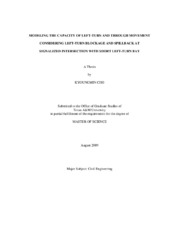| dc.description.abstract | This research presents more realistic models for left-turn and through volume capacity by taking into account the probabilistic nature of the left-turn bay blockages and spillbacks at a signalized intersection under the leading phasing scheme with a short left-turn bay. Generally, the left-turn bay spillback situation has been overlooked in the leading left-turn signal because much attention has been given to the more common problem of left-turn blockage under the leading left signal. The left-turn spillback situation, however, might happen because the ratio of left-turning vehicle tends to be relatively high in the traffic after the occurrence of left-turn bay blockage. That is, left-turn bay blockage, spillback situations, left-turn capacity, and through capacity are closely connected with one another.
Hence, this research estimates more precisely the capacity for through and left-turn movement by considering the left-turn bay blockage and spillback situations associated with left-turn bay under leading left-turn signal operations. In order to find general agreement between the results from this proposed model and a real-world situation, the developed capacity model is validated with the results from CORSIM simulations of a real-world signalized intersection. The binomial distribution is applied as the arrival distribution for through movement considering the characteristics of expected arrivals under heavy flow conditions. Finally, since left-turn bay blockage and spillback situation seem to have adverse impacts on each other, this research investigates if there are any dependent relationships between left-turn bay blockage and spillback. Here, this study confirmed that close relationships between left-turn bay blockage and spillback situations obviously exists. | en |


